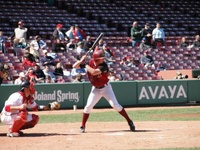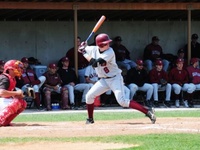When sophomore Tyler Albright sits behind the plate calling the pitch, he knows exactly where he wants the ball to end up. Like any good catcher, Albright’s looking for the ball to nestle in his glove for a strike. But if it doesn’t wind up with him, he’s got a couple of classmates ready and waiting to make the play.
“We try to get guys to ground out to Sean [O’Hara]—Sean’s potentially the best shortstop in the northeast,” Albright says. “And if it’s in the air, we want batters to pop out to Dillon [O’Neill]—Dillon can run down everything for us in the outfield.”
With Albright behind the plate, O’Hara at shortstop, and O’Neill patrolling center field, the three sophomores form the backbone of the Harvard baseball team.
“Right now, they are the heart and soul of our team,” Crimson coach Joe Walsh says. “With them up the middle, I just keep thinking that good things are going to happen.”
Albright, O’Hara, and O’Neill burst onto the scene last year as rookies, and very quickly became mainstays in the lineup. Their play was perhaps the one bright spot in Harvard’s 10-30 2008 season.
Adapting to the high level of Division I pitching takes every freshman a great deal of time, and Albright, O’Hara, and O’Neill were no different. But while their bats may have been slightly quiet, the three of them were able to make names for themselves immediately with some outstanding play in the field.
Albright had the highest fielding percentage of any Crimson player (with a minimum of 20 appearances), and he and O’Neill tied for the fewest errors on the squad. O’Hara was moved all around the infield, but was able to provide solid defense wherever he was used. This year, he’s back at home at short.
If there is to be a Harvard resurgence in 2009, the three of them will have a lot to do with it.
In Albright, the Crimson has a backstop with a rocket arm, capable of slowing down even the fastest of teams. The Long Beach, Calif. native has also been lauded for his game-calling skills.
Walsh recalls his recruiting trip to watch Albright play. He had just spent the entire summer looking for a catcher to bring in, with little success. But in October, he got the chance to see Albright’s Woodrow Wilson High School in action.
“When you think of a catcher, you think of defense and being able to shut down the running game,” Walsh says. “I saw one inning of Tyler, and I knew he was our guy.”
While Albright’s arm strength stops teams from stealing bases, the same attribute helps O’Hara keep runners off the basepaths altogether. The shortstop has already made some tremendous plays this season, exhibiting a calm demeanor throughout.
“Sean’s very smooth, and he makes plays that are difficult look pretty routine,” O’Neill says. “He never really looks like he’s trying too hard, which inspires confidence in the team.”
On the team’s latest trip down to Florida, legendary Mississippi State coach Ron Polk—now an assistant with UAB—took notice of O’Hara’s nifty glove.
“Ron, who basically is college baseball for me, goes, ‘I love your shortstop,’” Walsh recounts.
If the ball does find its way out of the infield, the team has total faith in its next line of defense. O’Neill—known for his speed—covers a ton of ground in the outfield.
“Dillon’s a real emotional guy,” Albright says. “On the field he really tries to take control—he’s going to go after a ball in the outfield every time, and anything he can get to, the other outfielders let him take, even if it’s not his ball.”
The three players seem to know each other inside out. Albright and O’Neill are roommates on campus, and O’Neill and O’Hara tend to room together when the team travels. The relationships come full circle on the field, where O’Hara communicates with Albright through signals, helping the catcher deal with runners on base.
The fact that the three sophomores have been counted on for nearly errorless defense so far in 2009 hasn’t shocked anyone.
But in Harvard’s opening eight games, there has been one unpleasant surprise for its opponents: these guys can hit too.
All three have already developed into serious double-threats in their short Crimson careers.
The end of last season saw Albright, O’Hara, and O’Neill become more comfortable at the plate. Albright finished with a .370 batting average and a .412 on-base percentage in Ivy games, while O’Hara hit safely in 14 of the team’s final 15 contests.
O’Neill had always been the prototype leadoff man with his knack for drawing walks and stealing bases, but was also able to increase his batting average by nearly 40 points in league play.
And the three have showed even more improvement with the bat this year.
O’Neill started the season with a two-hit performance against Jacksonville St., and continues to display the athleticism, patience and speed that make him the first name on Walsh’s lineup card every game.
Meanwhile, Albright has gained 15 pounds and seems to be hitting the ball a lot harder than last season. What’s more, he actually leads the team in runs.
What allows a catcher who hits in the No. 5 spot to lead the team in runs? The Crimson has been getting significant production from the bottom of its order. O’Hara, who has been hitting seventh, is batting .345 on the year.
At the plate and in the field, Albright, O’Hara, and O’Neill have quickly become key components for Harvard. Together, they form a very solid young core up the middle.
“They’ll be the foundation of our baseball team in the next couple of years,” Walsh says.
—Staff writer Jay M. Cohen can be reached at jaycohen@fas.harvard.edu.
Read more in Sports
Harvard Stadium To Host Nighttime Duel















